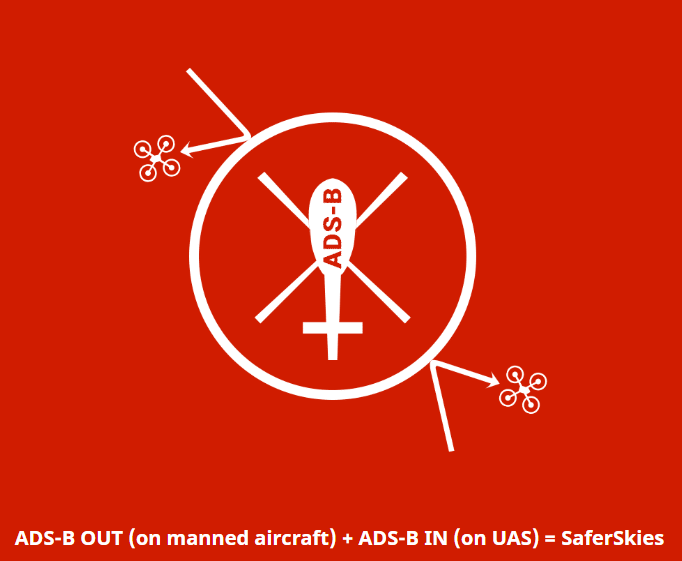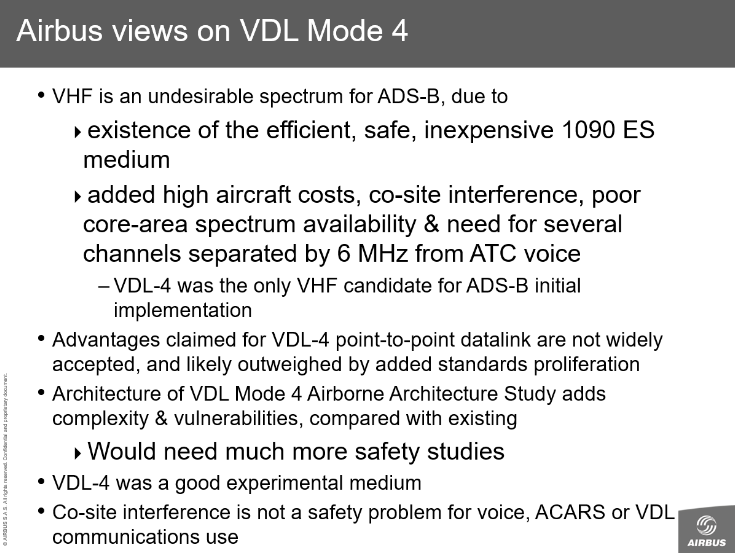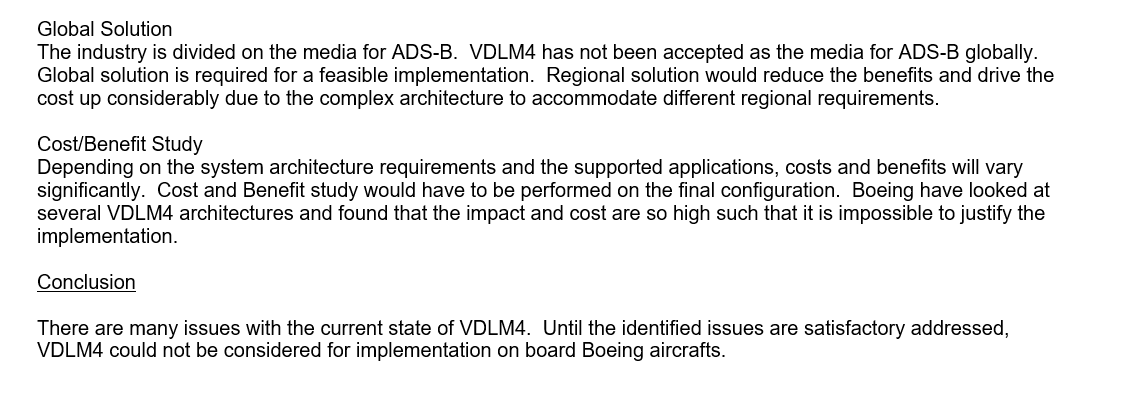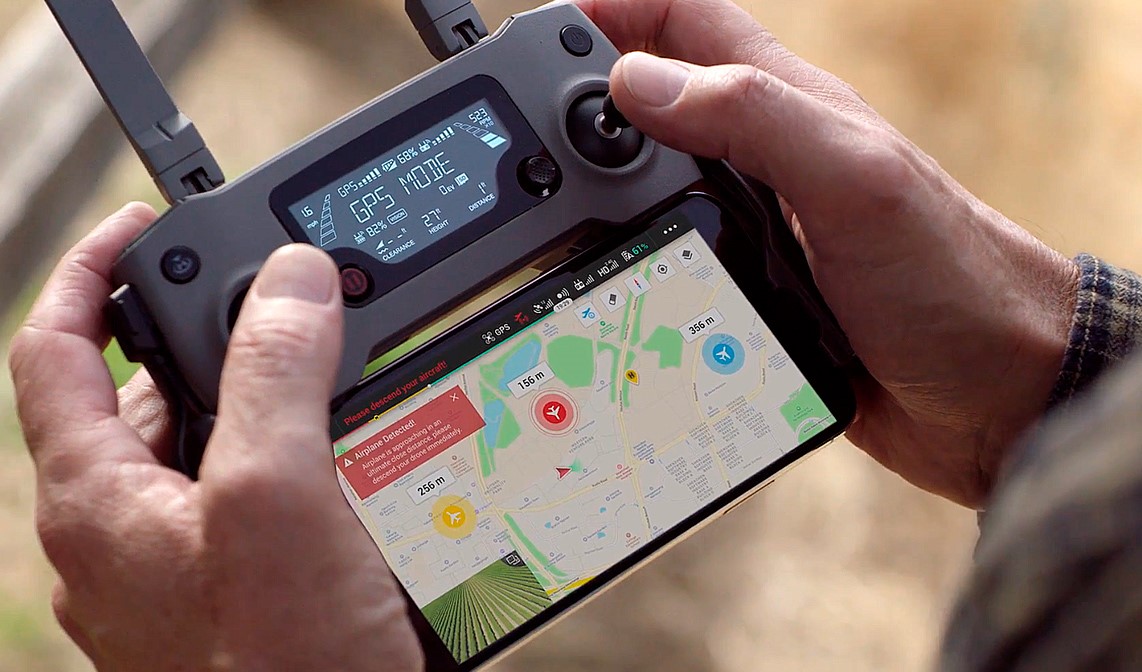AZN-V as a surveillance technology for drones
To make drones visible to aircraft pilots and controllers is the main task for today. To solve it, there are several potentially applicable technologies at once, and the debate about which is better does not subside. In this material, we will touch on automatic dependent surveillance-broadcasting (AZN-V), because it is it that is the international aviation standard used for surveillance in civil aviation (GA).
This is not the first year that AZN-V has been tested for UAVs. Nevertheless, even within this area, there are several different points of view at once.
Historically, only three data lines have been developed in the world: 1090ES, UAT and VDL-4. To date, only two of them are used in aviation - 1090ES and UAT. UAT is used exclusively in the United States for general aviation (GA). 1090ES - throughout the rest of the world, as well as in the United States for commercial aircraft. If you find mention of AZN-B in the media, then with a high degree of probability we can say that we are talking about either 1090ES or UAT. However, in Russia the situation is somewhat different, work is underway with AZN-B 1090ES, and there are also some developments based on the VDL-4 created in Sweden.
Test flights with the use of small-sized transponders AZN-V 1090ES for drones in Russia are not new and have been performed more than once. Among them, flights in Kronstadt and in the Moscow Region last year, which RIA-Novosti previously wrote about, can be distinguished. In both cases, it was demonstrated how, using the AZN-B 1090ES mobile transponders, drones became visible to aircraft pilots, as well as to ground services. Test flights with AZN-V VDL-4 equipment were announced during MAKS-2019, however it is difficult to judge how successful they were.
For reference
Automatic dependent surveillance-broadcasting or AZN-V is a technology that allows the aircraft to determine their coordinates using satellites, and then broadcast this and other information on the air in the broadcast range for other aircraft and ATM services. Thanks to AZN-B, the famous Flightradar24 service is operating, which displays real-time information about aircraft. The technology has several advantages, including a high rate of data update (for traditional radars, it is about 10 seconds, for AZN-V - one second). For clarity, below is an illustration of how the traditional secondary radar and AZN-V work.
Secondary Radar:

www.ads-b.com
AZN-B:

www.ads-b.com
According to experts , the main advantage of using ADS-V technology for drones lies precisely in its compatibility with aviation. Judge for yourself by equipping UAVs with mobile transmitters compatible with those already on airplanes, you can immediately make them visible to pilots. And vice versa, if the UAV is equipped with a AZN-V 1090ES receiver, then it will be able to "see" the planes surrounding it. In this case, you do not have to re-equip the entire fleet with new equipment. That sounds awesome.

uavionix.com/the-battle-for-drone-tracking-technology
Manned aircraft are already being used by AZN-B 1090ES transponders, and the number of such aircraft is growing steadily. The EU reported that over the past year, the airborne equipment of the AZN-B 1090ES has doubled and reaches 40% (data for April 2019). It is not the first year that equipment has been put on new airliners right at the factory. By the way, the new innovative Russian airliner MS-21 will also be equipped with the AZN-B 1090ES, which is called “by default”.
It is important to pay attention to the fact that the above strengths of AZN-V are fully applicable only to the 1090ES data line. UAT is used only for GA aircraft and only in the USA. VDL-4, in principle, cannot boast of either a large number of equipped aircraft in the sky, or a global growth trend - this type of LPD is not accepted for operation by any country in the world. After conducting a number of studies and working groups, world civil aviation de facto opted for the AZN-B 1090ES. Now this data line is used in more than 50 countries of the world. UAT has remained an exceptional feature of the United States, and talk of VDL-4 in the global space has virtually ceased.
For reference
Frequencies:
978 MHz (UAT);
1090 MHz (1090ES);
108-118 MHz (VDL-4).
Data rate:
1 Mbps (1090ES and UAT);
19.2 Kbps (VDL-4).
Countries:
United States (UAT);
USA, EU, UK, India, Australia, Indonesia and others (~ 50 countries, 1090ES);
Sweden, Russia (VDL-4, trial operation).
Dale Stacey / Aeronautical Radio Communication Systems and Networks
It is worth noting that as early as the 2000s, Airbus formulated a list of questions for the VLD-4 data line, a number of them, apparently, became critical for the further development of the standard. Among them was that the VHF band is not effective for use in AZN-V. As part of the ICAO working group, other bottlenecks were identified: possible interference, because VHF is already being used on board; low data transfer rate - 19 Kbps versus 1 Mbps for 1090ES and UAT. Also, Airbus noted that the highlighted possibility of direct point-to-point interaction is not widely applicable in practice.

Download "Airbus work on VDL Mode 4"
Boeing conducted its research and also reported that the transmission of the VDL-4 signal is accompanied by an increase in the amount of interference for the existing voice communication of the aircraft. In the end, the company concluded that there are still a number of problems, and until they are resolved, VDL-4 cannot be introduced on Boeing aircraft.

Download “Boeing Position Paper on VDLM4”
These conclusions were made in the early 2000s and since then, not one of the aircraft manufacturers has started working with VDL-4.
The development program of ADS-B and other surveillance equipment in Europe (“ ADS-B and other means of surveillance implementation status ”) presents plans for the development of ADS-B infrastructure 1090ES. On a global scale, a similar picture can be observed - out of more than 100 AZN-V projects around the world, almost all are connected with 1090ES LPD. One of the most interesting cases of the introduction of ADS-B is Australia. The AZN-B 1090ES network was deployed throughout the country with support for transmitting data from airborne outlets and receiving data from airborne inlets. Thus, the aircraft were able to see each other directly.

Australian Goverment - Civil Aviation Safety Authority: Chapter 4 Surveillance and ADS-B
Then Australia refused to introduce two LPDs (as in the USA) due to the redundancy and high cost of the dual system. The UAT's main strength is that FIS-B weather reporting was not rated as critical.
What about drones? Today, a large number of countries and organizations are actively conducting test UAV flights. By the way, many innovative projects have started in Australia. The American Google Wing and Amazon PrimeAir conducted their first pilot flights here. To date, Google Wing has already launched a grocery delivery service, and Uber has chosen Melbourne as its first international taxi city.
In other countries, large-scale UAV tests are also being conducted, they include city flights, cargo delivery, air taxi flights, long-distance flights, and so on. Among the technologies used, 4G and 5G networks are actively tested (as a promising tech. For cities of the future), AZN-V 1090ES / UAT and FLARM.
Among the significant events, one can single out that the world's largest drone manufacturer - DJI confirmed plans to install AZN-B 1090ES / UAT receivers on all of its drones weighing more than 250 from 2020. The company notes that this technology will allow UAVs to see manned aircraft / helicopters nearby, which will significantly improve flight safety today and will not require re-equipment of aircraft.

www.dji.com/flysafe/airsense
The general geography of UAV testing projects is very extensive: these are flights within the SESAR U-Space in Europe, and NASA and FAA flights in the USA, flights in India, Japan, Australia and New Zealand, and so on. Moreover, some countries have already begun to use drones for the delivery of small cargoes for commercial purposes, among them Australia, Finland, and the USA. In such projects, in addition to communication and surveillance technologies, the organizers especially highlight a single data exchange system - FIMS. Such a system is a kind of connecting link and unites UAVs, service providers, as well as national air traffic management systems. FIMS is a separate interesting topic and we will talk about it in future materials.

Switzerland's U-Space: Enabling a “Safe and Open Drone Economy” With Aviation Data Exchange Hub
This is not the first year that AZN-V has been tested for UAVs. Nevertheless, even within this area, there are several different points of view at once.
Historically, only three data lines have been developed in the world: 1090ES, UAT and VDL-4. To date, only two of them are used in aviation - 1090ES and UAT. UAT is used exclusively in the United States for general aviation (GA). 1090ES - throughout the rest of the world, as well as in the United States for commercial aircraft. If you find mention of AZN-B in the media, then with a high degree of probability we can say that we are talking about either 1090ES or UAT. However, in Russia the situation is somewhat different, work is underway with AZN-B 1090ES, and there are also some developments based on the VDL-4 created in Sweden.
Test flights with the use of small-sized transponders AZN-V 1090ES for drones in Russia are not new and have been performed more than once. Among them, flights in Kronstadt and in the Moscow Region last year, which RIA-Novosti previously wrote about, can be distinguished. In both cases, it was demonstrated how, using the AZN-B 1090ES mobile transponders, drones became visible to aircraft pilots, as well as to ground services. Test flights with AZN-V VDL-4 equipment were announced during MAKS-2019, however it is difficult to judge how successful they were.
For reference
Automatic dependent surveillance-broadcasting or AZN-V is a technology that allows the aircraft to determine their coordinates using satellites, and then broadcast this and other information on the air in the broadcast range for other aircraft and ATM services. Thanks to AZN-B, the famous Flightradar24 service is operating, which displays real-time information about aircraft. The technology has several advantages, including a high rate of data update (for traditional radars, it is about 10 seconds, for AZN-V - one second). For clarity, below is an illustration of how the traditional secondary radar and AZN-V work.
Secondary Radar:

www.ads-b.com
AZN-B:

www.ads-b.com
According to experts , the main advantage of using ADS-V technology for drones lies precisely in its compatibility with aviation. Judge for yourself by equipping UAVs with mobile transmitters compatible with those already on airplanes, you can immediately make them visible to pilots. And vice versa, if the UAV is equipped with a AZN-V 1090ES receiver, then it will be able to "see" the planes surrounding it. In this case, you do not have to re-equip the entire fleet with new equipment. That sounds awesome.

uavionix.com/the-battle-for-drone-tracking-technology
Manned aircraft are already being used by AZN-B 1090ES transponders, and the number of such aircraft is growing steadily. The EU reported that over the past year, the airborne equipment of the AZN-B 1090ES has doubled and reaches 40% (data for April 2019). It is not the first year that equipment has been put on new airliners right at the factory. By the way, the new innovative Russian airliner MS-21 will also be equipped with the AZN-B 1090ES, which is called “by default”.
It is important to pay attention to the fact that the above strengths of AZN-V are fully applicable only to the 1090ES data line. UAT is used only for GA aircraft and only in the USA. VDL-4, in principle, cannot boast of either a large number of equipped aircraft in the sky, or a global growth trend - this type of LPD is not accepted for operation by any country in the world. After conducting a number of studies and working groups, world civil aviation de facto opted for the AZN-B 1090ES. Now this data line is used in more than 50 countries of the world. UAT has remained an exceptional feature of the United States, and talk of VDL-4 in the global space has virtually ceased.
For reference
Frequencies:
978 MHz (UAT);
1090 MHz (1090ES);
108-118 MHz (VDL-4).
Data rate:
1 Mbps (1090ES and UAT);
19.2 Kbps (VDL-4).
Countries:
United States (UAT);
USA, EU, UK, India, Australia, Indonesia and others (~ 50 countries, 1090ES);
Sweden, Russia (VDL-4, trial operation).
Dale Stacey / Aeronautical Radio Communication Systems and Networks
It is worth noting that as early as the 2000s, Airbus formulated a list of questions for the VLD-4 data line, a number of them, apparently, became critical for the further development of the standard. Among them was that the VHF band is not effective for use in AZN-V. As part of the ICAO working group, other bottlenecks were identified: possible interference, because VHF is already being used on board; low data transfer rate - 19 Kbps versus 1 Mbps for 1090ES and UAT. Also, Airbus noted that the highlighted possibility of direct point-to-point interaction is not widely applicable in practice.

Download "Airbus work on VDL Mode 4"
Boeing conducted its research and also reported that the transmission of the VDL-4 signal is accompanied by an increase in the amount of interference for the existing voice communication of the aircraft. In the end, the company concluded that there are still a number of problems, and until they are resolved, VDL-4 cannot be introduced on Boeing aircraft.

Download “Boeing Position Paper on VDLM4”
These conclusions were made in the early 2000s and since then, not one of the aircraft manufacturers has started working with VDL-4.
The development program of ADS-B and other surveillance equipment in Europe (“ ADS-B and other means of surveillance implementation status ”) presents plans for the development of ADS-B infrastructure 1090ES. On a global scale, a similar picture can be observed - out of more than 100 AZN-V projects around the world, almost all are connected with 1090ES LPD. One of the most interesting cases of the introduction of ADS-B is Australia. The AZN-B 1090ES network was deployed throughout the country with support for transmitting data from airborne outlets and receiving data from airborne inlets. Thus, the aircraft were able to see each other directly.

Australian Goverment - Civil Aviation Safety Authority: Chapter 4 Surveillance and ADS-B
Then Australia refused to introduce two LPDs (as in the USA) due to the redundancy and high cost of the dual system. The UAT's main strength is that FIS-B weather reporting was not rated as critical.
What about drones? Today, a large number of countries and organizations are actively conducting test UAV flights. By the way, many innovative projects have started in Australia. The American Google Wing and Amazon PrimeAir conducted their first pilot flights here. To date, Google Wing has already launched a grocery delivery service, and Uber has chosen Melbourne as its first international taxi city.
In other countries, large-scale UAV tests are also being conducted, they include city flights, cargo delivery, air taxi flights, long-distance flights, and so on. Among the technologies used, 4G and 5G networks are actively tested (as a promising tech. For cities of the future), AZN-V 1090ES / UAT and FLARM.
Among the significant events, one can single out that the world's largest drone manufacturer - DJI confirmed plans to install AZN-B 1090ES / UAT receivers on all of its drones weighing more than 250 from 2020. The company notes that this technology will allow UAVs to see manned aircraft / helicopters nearby, which will significantly improve flight safety today and will not require re-equipment of aircraft.

www.dji.com/flysafe/airsense
The general geography of UAV testing projects is very extensive: these are flights within the SESAR U-Space in Europe, and NASA and FAA flights in the USA, flights in India, Japan, Australia and New Zealand, and so on. Moreover, some countries have already begun to use drones for the delivery of small cargoes for commercial purposes, among them Australia, Finland, and the USA. In such projects, in addition to communication and surveillance technologies, the organizers especially highlight a single data exchange system - FIMS. Such a system is a kind of connecting link and unites UAVs, service providers, as well as national air traffic management systems. FIMS is a separate interesting topic and we will talk about it in future materials.

Switzerland's U-Space: Enabling a “Safe and Open Drone Economy” With Aviation Data Exchange Hub
All Articles